~ POOR PRIESTS HOSPITAL ~
CANTERBURY
ON THE RIVER BANK IN STOUR STREET, FOUNDED 1220
NOW USED AS THE CANTERBURY HERITAGE MUSEUM WITH RUPERT BEAR MUSEUM
Became the workhouse (bridewell) in 1712 [28?]
By 1860 it was used as the Police Station as well as the Blue Coat Boys School
"It escaped the general suppression of such houses, but was granted by Queen Elizabeth to the mayor and commonalty, for the use of the poor of this city. For many years afterwards it was called the Bridewell Hospital, from its having been made use of as such - there being kept in it a number of Bridewell or blue-coat boys, being poor townsmen's children; but a general Workhouse being established in 1712, for the relief and employment of the poor in this city, this house was allotted for that purpose, since which it has been usually known by the name of the City Workhouse." HW
"Granted by Queen Elizabeth
in 1574, to the Mayor and Commonalty of the city, who make use of it
for the maintenance and lodging of several poor boys and as a house
of correction, called the Bridewell; the boys are called Bridewell-boys
or Blue-coat boys, from their dress, in which they usually attend the
Mayor, when he goes in his formalities to the cathedral or his own parish
church. In 1728, it was, by act of parliament, appointed to be the workhouse,
for the maintenance and employment of the poor of the city, under guardians,
incorporated for that purpose."
*the building ceased to be used as a workhouse when the present Union house was erected
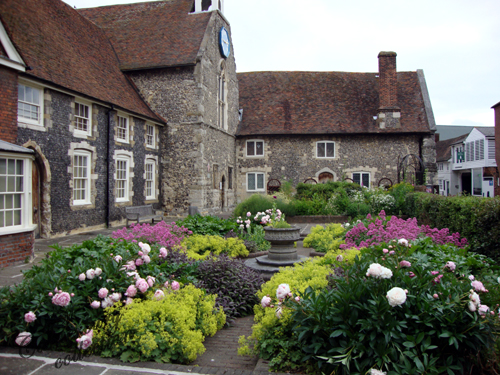
"1373 - The chapel and part of the hospital of Poor Priests, in the city of Canterbury, was now built of stone by Thomas Wike, master thereof."
"1575, April 10th - Twelve acres of land at Hackington, otherwise St. Stephenses, in the county of Kent, was by Robert Bacon, master of the Hospital of Poor Priests, in the city of Canterbury, leased by indenture to William Lovelace, serjeant-at-law, for the term of twenty-one years from the Annunciation of the blessed Virgin Mary then last past, at the yearly rent of two pound and ten shillings payable on the feasts of St. Michael the Archangel and the Annunciation aforesaid, by even portions, or within twenty-one days then after, or the said lessor may distrain for rent, as may appear in the counterpart executed by the said lessee."
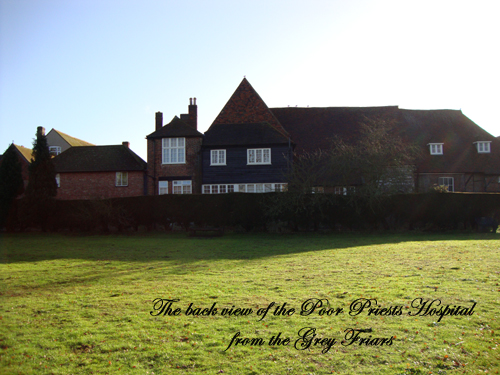
"The Annals of Poor Priests Hospital from its Foundation, and the Lands, Tenements, and Hereditaments thereunto belonging, granted by Queen Elizabeth to the Mayor and Commonality of the City of Canterbury, and by an Act of Parliament made in the First Year of King George the Second, vested in the Guardians of the Poor in the City of Canterbury"
Admissions of blue coat boys to poor priests hospital, CCA-CC-A/C/11
1828-35 Appointment of Blue Coat Boys to be confined to sons of Freemen of this City only CCA-CC-A/C/13
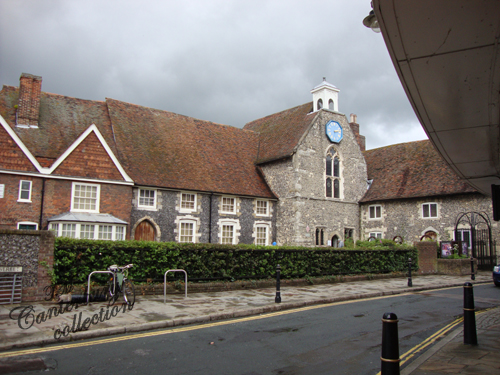
"The Blue coat school was established by the mayor and commonalty, to whom Queen Elizabeth had granted an hospital founded prior to the year 1243, by Simon de Langton, Archdeacon of Canterbury, for poor priests, with all the lands belonging to it, which, by an act passed in the 1st of George II., was for the use of the poor, transferred to guardians incorporated by the same act, upon their undertaking also to provide for sixteen poor boys of the city, to be called Blue Coat boys: the estate at present produces £795. 8. 6. per annum; and sixteen boys, nominated by the mayor and commonalty, are clothed, maintained, and instructed in reading, writing, and arithmetic, and on leaving school are apprenticed with premiums, which, though originally fixed at £5, are according to circumstances increased to £21." A Topographical Dictionary of England 1831
"The Blue Coat School was founded by the mayor and commonalty out of a gift by Queen Elizabeth of an hospital with the lands belonging to it. In it 16 boys are clothed, maintained, and instructed in reading, writing, and arithmetic, and on leaving school, apprenticed with premiums. They are nominated by the mayor and commonalty." Parliamentary Gazetteer of England and Wales 1851
Became part of the Simon Langton Schools
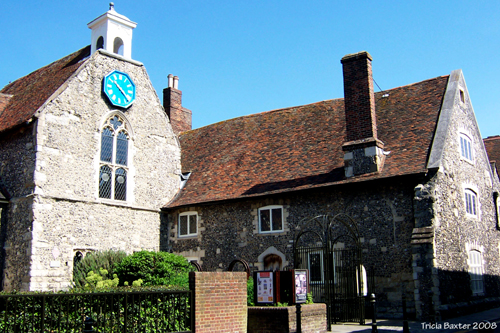
1240 - The Hospital of Poor Priests, in the city of Canterbury, was built and founded by Simon Langton, archdeacon of the said city, with the charitable benevolence of divers people, dedicated to the blessed Virgin Mary, with the chapel contiguous, situate in the parish of St. Margaret, in the said city, where the dwelling of Lambin Flemming some time was, adjoining southward to the Straightened Lane leading from Stour Street, in the said parish, to the Common Washing Place westward to the river Stour, northward to the dwelling of Robert de Hotwell, and eastward to the highway there, and behind the said hospital the island was called With, and belonged to and served them for a garden.
1242 - The house and land at Hotwell, between the chapel of the Hospital of Poor Priests, in Canterbury, towards the south, and a certain lane which leads to the island With towards the north, and the highway towards the east, the Poor Priests of the said hospital, by charter, released all their right therein to the jealous monks of Christ Church, Canterbury.
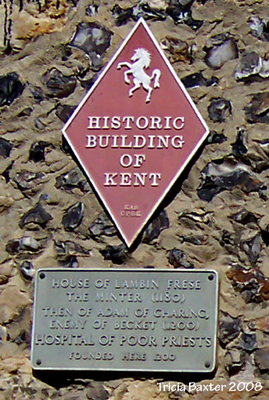
1243 - The church of St. Mary of Stodmarsh, in the county of Kent, in the patronage of the abbot and convent of St. Augustine, in the said county, was passed over, with the profits of four acres of land thereto adjoining, at the instance of Simon de Langton, Archdeacon of Canterbury, by a perpetual grant of the said abbot and convent to the Hospital of Poor Priests, in Canterbury, on condition that the Poor Priests of the said hospital, or their procurators, should not appropriate to themselves any lands or rents of the tenants of the said abbot and convent without their special leave, nor require for the future any tithes of their lordship of Stodmarsh aforesaid; and that the syndic of the said hospital, and his successors, should swear fealty to the said abbot and convent and annually on St. Augustine's day offer a pound wax taper on the great altar of their church in acknowledgment of the premises.
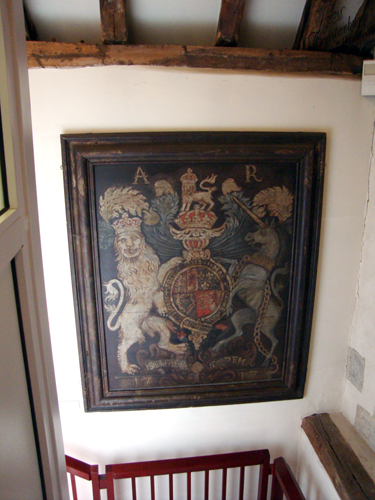
1264 - A composition was made between the parson of St. Margaret's church in Canterbury, and the Hospital of Poor Priests, in the said city. That the chaplain who ministered in the chapel of the said hospital should not knowingly receive an oblations, tithes, or offerings belonging to the said church, and if he should receive such ignorantly, he should restore them to the said parson; and the people in the said hospital should receive from the said parson the sacraments as parishioners of the said parish of St. Margaret, in Canterbury aforesaid, and should come to the said church on the holy festivals, and offer as the said parishioners should; also the same should be observed in the said hospital as well by the laity as by the traveling clergy from whensoever they shall come, so as to be made a custom there; and likewise if any of the said foreign priest be sick, he should be placed in the said hospital, and receive the sacraments from the said chaplain, and if he die, be buried in the said hospital; but the said chaplain and Poor Priests of the said hospital should receive the sacraments from the said parson, or from him whom he should intrust with the spiritualities of the said church, and have power to choose their burying-place; and likewise without slander receive the yearly or third year's profits paid by the pious who were not parishioners, as aforesaid, so that it was not to the prejudice of mother church, which if it was they should restore it; moreover they should annually pay one pound of cummin seed, instead of tithes, to the said parson, on the feast of St. Margaret; and offer on the great altar of the said mother church, in acknowledgment of their parochial right, two wax candles of three pounds weight, and of eight or ten pence value; and if any one dwell in the island Bennewith, he should still be a parishioner of the said parish. Also of the abbot and convent of St. Augustine, in the county of Kent, they shall acquire no tenement without their leave, and if they should acquire any tenement of any other lord, the right which he had at first shall be saved to mother church. Also if it shall happen the said chaplain should not officiate in the said hospital, but by a lay procurator, he should swear to observe the premises; but on Sundays and festivals, when it is customary to make oblations, mass should not be celebrated in the said hospital until the Gospel was read and mass consummated in the said church, unless by licence from the said parson; and on those days the parishioners aforesaid should not be admitted until mass was accomplished there; and they should have no bells; but if the said chaplain or his procurator should act contrary to these premises, he should pay to the abbot aforesaid, or the archdeacon of the said city, or whom they should appoint, one mark for every such offence; and the said composition still remain in force.
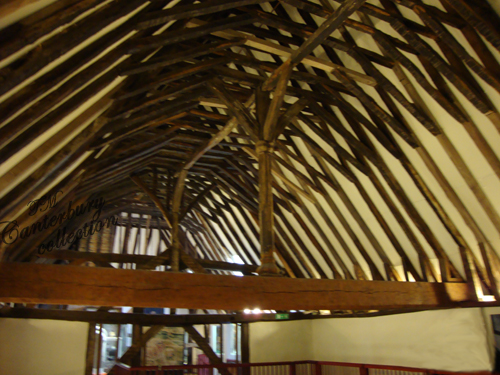
1278 - The church of St. Margaret, in Canterbury, was given to the Hospital of Poor Priests, in the said city, in full and perpetual alms, by R., abbot of the convent of St. Augustine, in Kent, and was of their patronage; and that the syndic and priests of the said hospital should not purchase or appropriate to themselves any lands, rents, or tenements within the parish of St. Margaret aforesaid, of the tenants of the said abbot and convent, without their special leave; and the syndic of the hospital aforesaid in acknowledgment of the right and jurisdiction of the said abbot and convent in the same, should swear fealty to them in their chapter when he should be required; and that as oft as the said abbot should pass by the said church the bell should toll.
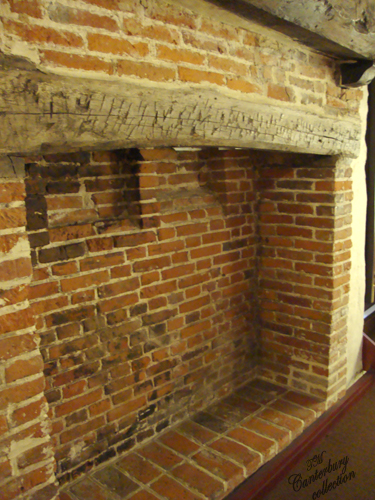
1511 - The mastership of the Hospital of Poor Priests, in the city of Canterbury, with the Curacy of St. Margaret, was presented by Archdeacon Warham to Philip Taylor.
Philip Martyn, Master of the Poor Priests
Hospital presented for throwing horse manure into the river Stour.
CC/JQ/314/viii 1514
Philip Taillor, Master of the Poor Priests Hospital for encroachment on the river Stour. CC/JQ/314/ix 1515
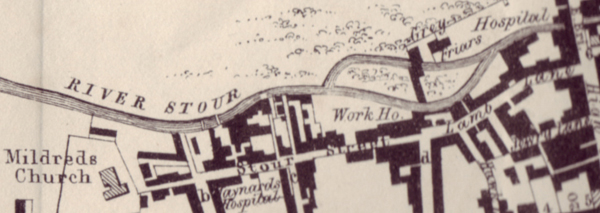
1843 map showing the workhouse in Stour Street / Lamb Lane (Poor Priests Hospital)
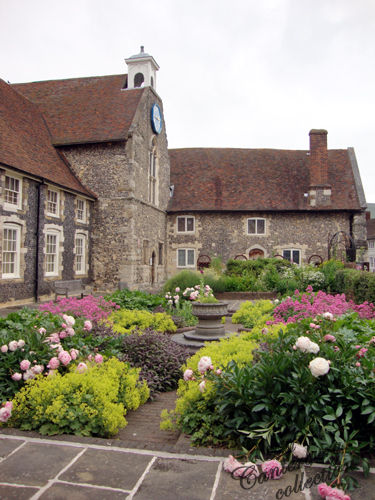
1531 - Upon the death of Philp Taylor, the mastership of the Hospital of Poor Priests, in the City of Canterbury, with the curacy of St. Margaret in the said city, was presented by Archdeacon Warham to Nicholas Langton, Master of Arts.

1554 - July 27th, Hugh Barret, priest, was admitted to the Hospital of Poor Priests, in the city of Canterbury, and to the curacy of St. Margaret's church, in Canterbury aforesaid, appropriate to the said hospital, void by the death of Nicholas Langton, the last incumbent, and was presented thereto by the venerable Mr. Nicholas Harpesfield, LL.D. archdeacon of Canterbury, and patron thereof; and the said Hugh Barret was canonically invested in all the rights and appurtenances of the same, and had the cure of souls committed to him, with a salvo of the capitulary rights, honours, and dignity of the metropolitical church of Canterbury, an oath being first made by James Cancellor, his procurator, that he would observe the statures and ordinance of the said hospital according to its foundation.
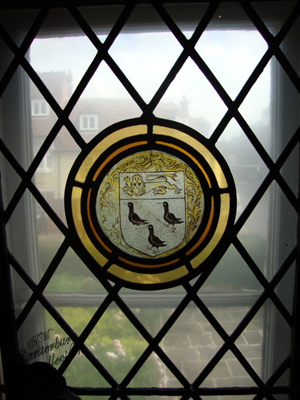
1560 - The mastership of the hospital of Poor Priests, in the city of Canterbury, with the curacy of St. Margaret's church, in the said city, was presented by Archdeacon Edmund Gheast to Robert Bacon.
1575 - April 10th - Twelve acres of land at Hackington, otherwise St. Stephenses, in the county of Kent, was by Robert Bacon, master of the Hospital of Poor Priests, in the city of Canterbury, leased by indenture to William Lovelace, serjeant-at-law, for the term of twenty-one years from the Annunciation of the blessed Virgin Mary then last past, at the yearly rent of two pounds and ten shillings, payable on the feasts of St. Michael the Archangel and the Annunciation aforesaid, by even portions, or within twenty-one days then after, or the said lessor may distrain for rent, as may appear in the counterpart executed by the said lessee.
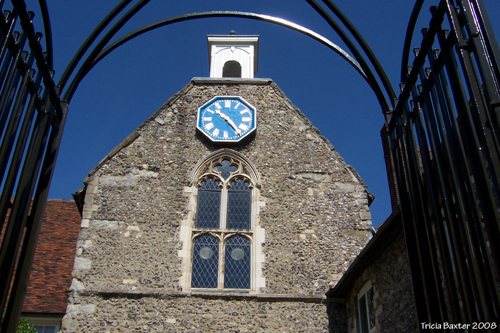
1575 - April 11th A bond was given in the penalty of six pounds by the mayor and commonalty of the city of Canterbury, under their common seal, to William Lovelace, serjeant-at-law, on condition that they, whensoever the Hospital of Poor Priests, in the city of Canterbury, with the lands, tenements, and hereditaments thereunto belonging, should come into their possession they should then give the orchard in the said city, between the Stour and the then dissolved Hospital of the Grey Friars, to him and his heirs for ever, and build a bridge from his garden over the Stour to him and his heirs use for ever, then the same to be void, or else to remain in foree.
1575 - The mastership of the Hosptial of Poor Priests, in the city of Canterbury, with the curacy of St. Margaret, was presented by Archdeacon of Canterbury, Edmund Freak, to Blase Winter.
1575 - May 10th, The Hospital of Poor Priests, in the city of Canterbury, with all its possessions was surrendered to Elizabeth, Queen of England, France, and Ireland &c. by Matthew Parker, Archbishop of Canterbury and ordinary thereof; Edmund Freak, Arcdeacon of Canterbury, and patron thereof; and Blase Winter, syndic thereof.
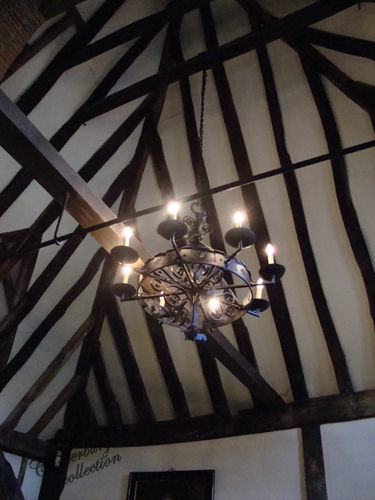
1575 - July 5th - The hospital of Poor Priests, in the city of Canterbury, and all and singular the houses, buildings, structures, gardens, orchards, arable-lands, glebes, tenements, meadows, pastures, marshes, woods, underwoods, rents, services, tenths of grass, corn and hay, and the reversion and reversions of all and singular the premises and profits, liberties, franchises, emouluments and hereditaments belonging to the said hospital, as well within the said city as in the county of Kent, was by letters patent under the Privy Seal of Her Majesty Elizabeth, Queen of England, France and Ireland &c. granted to the mayor and commonalty of the said city, for the use of the poor of the said city, to hold of her said Majesty, her heirs and successors, as of her manor of East Greenwich, in free socage, by fealty only, and not in chief - signed by Lutley. The same year, John Rose, mayor of the said city, was reimbursed in the sum of fifty pounds, by cess made upon and collected from the citizens of the said city, which money he had disbursed in procuring the said hospital, with its appurtenances, to be granted as aforesaid.

"The Poor Priests Hospital adjoining the Grey Friars. The members of the original mission were received and entertained here after a sojourn of two days at the Priory of Holy Trinity (The Cathedral) until accommodation in the present site was provided."from the reverse of the postcard
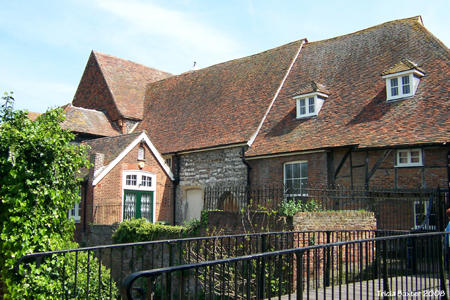
"The back of the Poor Priests Hospital now from the same angle, showing all the changes"
"History of the Canterbury Workhouse"
As the history of the way in which the Canterbury Workhouse, together with the lands which have always been attached to it, came into the hands of the Canterbury Guardians is remarkable, I add the following account:
It appears that about ninety years ago, the Guardians, wishing to preserve a history of the property of which they were trustees, caused some old records, of whose present existence I am not aware, to be copied, which contained an epitome of the events relating to the Poor Priests' Hospital (now the workhouse), which had occured from its foundation in 1240 to the time when the buildings, together with the lands that supported the institution, came into the possesion of the city by the grant of Queen Elizabeth. I have caused this account to be copied, and I will only observe, in elucidation, that Simon Langton, the founder of the hospital, was brother of Stephen Langton, the well known Archbishop of Canterbury. The probable design of the institution was to afford an asylum to those of the clergy who fell sick while visiting the shrine of Becket, then 1240, in the height of its celebrity. It escaped in the general suppression of religious houses by Henry VIII., most likely on the ground of its hospital character, but was subsequently, in 1575, surrendered to Queen Elizabeth, and by her immediately granted to the mayor and commanality of Canterbury, by whom the property was made over in 1727, under the provisions of the Local Act, to the Guardians of the Poor, for the purpose of maintaining a workhouse, a bride well, and a blue-coat charity school. The annals would seem to hint that that the surrender to the Queen, and subsequent grant to the city, was owing to some corrupt bargain between the mayor and commanalty and a Serjeant Lovelace, who was to receive, in case the transaction was completed, an orchard, and to have a bridge built from his garden, across the River Stour, at the expense of the city. It may appear extraordinary that such a circumstance, if it was of the character I have ascribed to it, should have been recorded at all; but it should be observed that it occurs in the annals of the Poor Priests; Hospital, that were probably compiled by one of the members of the society, who would of course have no motive to conceal a transaction that reflected discredit on those who were obtaining possession of property that rightfully belonged to the body of which he was a member.
Annual Report of the Poor Law Commission 1843
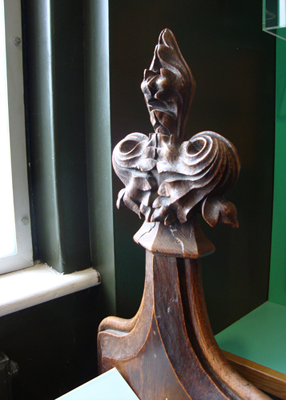
The Canterbury Guardians have appointed a committee, with whom the medical officer is associated to consider the steps necessary for the provision of a new workhouse infirmary in place of the present one, which has been condemned by the Poor Law Board. The Lancet, April 24, 1869

The Bridewell, or poor priests's hospital, stands in Lamb-lane, not far from the south side of the High Street. It was first founded about the year 1240, by Simon Langton, archdeacon of Canterbury, and brother to the great archbishop of that name. This hospital, intended as a place of succour and relief for poor priests "chaplains, curates, and other like unbeneficed clerks" escaped the general dissolution, and remained unsuppressed down to the time of Queen Elizabeth, when it was turned into a workhouse. It has since served both as a prison and a poorhouse, and it is now the city workhouse. The buildings have been sadly altered. Knight's Excursion Companion 1851
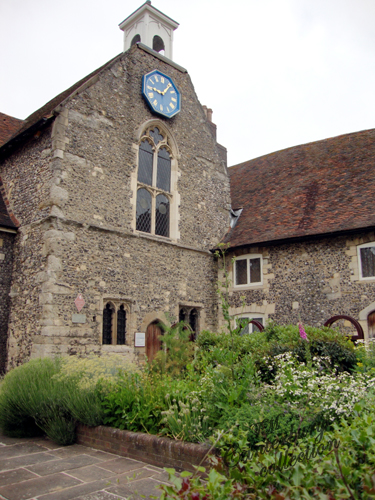
& Student's of the Blue Coat School: Joseph MARSH, William F. THOMAS, William H. LAMING, John W. CROW, John G. WINCHESTER, George J. ELLIS, Frederick J. R. WRIGHT, George T SOMERFORD, Edward J. JOHNSON, George J. KENNETT, Edward MOYS, Arthur E. BOWEN, Edward T. PUYN, William W. WEST, Edwin A. BRADFORD, Harry MORGAN (all of Canterbury), Schoolmaster is John CAPLIN
Old Buildings in Canterbury - The Athenaeum, in a review of Mr. Shore's new book on Canterbury, remarks: "We are glad to see among the illustrations a good picture of the house of the Grey Friars, which stands over one of the streams of the Stour, supported by graceful arches and slender pillars of thirteenth century date. Until recently this building, which belongs to the Corporation, was in a foul state, and was virtually closed to all visitors. Lately, however, this restriction has been removed, and the building kept in a more creditable condition. The Corporation would be well advised to turn its attention to two other disgraces for which it is responsible, vis., the condition of the old Norman Castle, used as a coal store, and the sad state of the Poor Priests' Hospital, founded in 1240, and now partly used as a dwelling house and partly as a furniture store." (The writer is incorrect, we believe, in stating that the Grey Friars' house is the property of the Corporation. The present tenant is Mr. W. B. Pierce, and on application at his floral depot, St. Margaret's Street, admission tickets to this interesting house and grounds may be obtained.) K.G. & C.P., 1907
Used to house the Regimental Museum of the Buffs before it was moved the the Beaney in 1979. *originally at Howe Barracks
© T. Machado 2007
